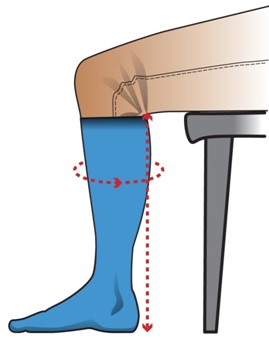It is now easier than ever to find the perfect riding boots that look fabulous and fit well!
Tall boots should look elegant and be durable, practical and comfortable. There are so many choices now in leather, design and technology – but a good fit remains the most important factor when shopping for that perfect pair of tall boots.
How to Measure for Stock Tall Riding Boots
You’ll most likely need to measure when deciding on the proper tall riding boot. This process is much easier if you ask a friend to help with the measurements!
- Wear the riding clothes (breeches and socks) you usually wear when riding.
- Sit in a chair with a flat straight seat and place your feet flat on the floor with knees at a 90° angle.
- Take the measurement around your calf at the widest part.
- Measure the height from the floor to the back of your knee.
Field Boots
Field boots have laces and are designed for the jumping disciplines. Field boots should be purchased taller than the final height required as they will drop, soften and crease around your ankle to allow for the correct leg position when riding.
Trying on Field Boots
When shopping for a new pair of tall boots try on different styles as they will fit differently.
The foot portion should be comfortable – not too tight, but also not too big. The sole should be comfortable, although it will often harder than the sole of a shoe.
You should purchase field boots 1 ½ to 2 inches taller than the final height required. The amount of drop depends on the cut of the boot and the softness of the leather. For field boots for which you want the maximum height after break-in, the front of the boot should rise to the middle of your kneecap. The boots will seem uncomfortably tall and will crease slightly at the top when you bend your knee. This crease will disappear when the boots drop. You can see how high your boot will appear after the break-in phase by placing a heel lift in the footbed to raise your leg inside the boot.
Pull on or zip up your boots. Use boot hooks help get your tall boots on! Initially, they should be difficult to tug on (and off). If your boots have zippers, you should be able to zip them all the way up and snap the closure at the top while standing. The boots should feel snug and tight around your calf without cutting off your circulation.
If the boot is too loose, when it breaks in and stretches it will develop deep folds around your ankle that may press into your skin and cause discomfort. Also, if the boot is too loose, it will drop too much and be too short in height. Boots without a zipper need to be a little difficult to get on and off as they need to fit snugly, and the leather will stretch over time.
Now walk around in the boots you are trying, bend your knees and crouch into a riding position. You may need to try insoles or heel lifts to get a better fit or more comfort.
Breaking-in Field Boots
You can prevent your new tall field boots from rubbing the back of your knees during the break-in period by using a heel lift. Socks such as slippery Zocks that make boots easier to slide on.
Dressage Boots
Dressage boots are made with stiffer leather than field boots, and are designed to drop less. The drop is usually about ¾ inch. Softer, finer leather will drop more than thicker leather. Dressage boots should be high enough at the knee to help achieve an elegant, elongated leg in the saddle. The front of the boot should rise to just under your kneecap. The inside of the boot should be just below the back of the knee once the boots are broken in.




